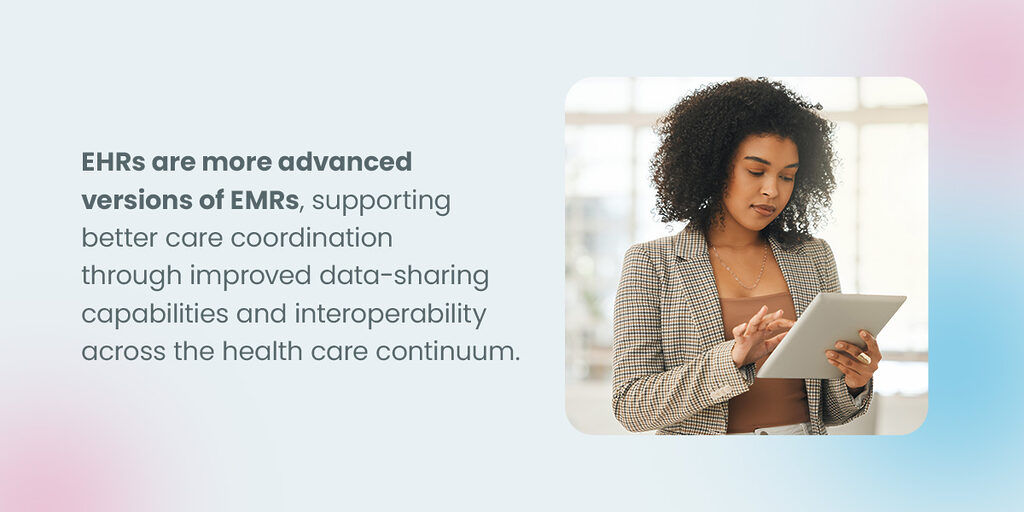
EHR vs. EMR Systems in Mental Health Care Organizations
Due to digitization, collecting, storing and using medical information has changed, and electronic medical records (EMRs) and electronic health records (EHRs) are the modern go-to options for all kinds of health care practices. However, EMRs and EHRs have significant differences in terms of data-sharing capabilities, scope of patient information, accessibility and interoperability.
What Are EMRs?
EMRs are digital versions of medical charts containing patient information such as:
- Demographics, like age and gender.
- Medical histories, like illnesses, family records, surgeries and vaccination records.
- Tests and laboratory results.
- Medications.
- Treatment plans.
The electronic data gathered in an EMR stays within a single health care organization. Supposing a patient visits a physician, dentist or surgeon in a particular medical facility, only that facility can access their information. EMRs are ideal for patients who remain with one health care provider for an extended period. These platforms allow health care providers to:
- Track patients’ data over time to provide quality health care services.
- Identify which patients are due for checkups or preventive screenings.
- Monitor and improve the health care of patients in one practice.
What Are EHRs?
EHRs are comprehensive electronic records of a patient’s health information that can be shared across multiple health care organizations. Unlike EMRs, which are typically limited to one practice, EHRs are designed to be accessed and utilized by different health care providers. For example, mental health clinics can use an EHR system for integrated care coordination.
EHRs have several benefits, including:
- Enhancing patient engagement through online portals for appointment scheduling and communication.
- Access to complete patient histories, resulting in more informed decision-making and better overall health outcomes.
- Providing patients access to their treatment plans and progress reports for increased involvement in their care.
- Enabling communication between health care providers in different organizations.
- Integration with telehealth features, allowing mental health professionals to conduct virtual sessions.
- Cost savings from reduced paperwork and improved billing accuracy, leading to long-term financial benefits.
What Are the Differences Between EHRs and EMRs?

There are four main distinctions between EHRs and EMRs:
- Data-sharing capabilities: EMRs are generally limited to a single practice or health care organization. EHRs are designed for sharing across several health care providers.
- Scope of patient information: EMRs focus on data from one practice. EHRs are comprehensive and include a wide range of health information from various providers.
- Accessibility: EMRs are generally accessible only to the health care provider using the system. EHRs are accessible to authorized health care providers across various settings.
- Interoperability: EMRs are usually designed for single practices with limited operability. EHRs are designed to work seamlessly with other EHR systems and health information exchanges (HIEs).
Overall, EHRs are more advanced versions of EMRs, supporting better care coordination through improved data-sharing capabilities and interoperability across the health care continuum. However, EMRs are still applicable in certain situations for different types of health care facilities.
What to Consider When Choosing an EHR or EMR System
Choosing an EHR or EMR system is a significant decision for health care organizations. Here are nine key factors to consider when making a choice:
- Usability and user experience: Choose a system with an intuitive, user-friendly interface that minimizes the staff learning curve. Also, ensure the system can be tailored to your practice’s specific workflows and needs. Usability contributes to the system’s efficiency.
- Patient engagement tools: Check if the system offers patient portals with features like appointment scheduling, prescription refills and access to health records. It also helps to choose a platform that facilitates communication between patients and providers.
- Customization and scalability: Determine how much you can customize report templates to specific behavior health assessment and treatment plans. Secondly, the system should be capable of growing with your practice.
- Features and functionality: Ideally, the system should have features for appointment scheduling, billing, patient charting and reporting. You may also need a system tailored to your specialty, such as behavioral and mental health practice.
- Interoperability: Assess how well the system integrates with other systems to facilitate data sharing. When choosing an EHR, check whether it supports HIEs to improve collaboration with other health care providers.
- Vendor reputation and stability: Research the vendor’s market experience and track record with similar practices. You may read customer reviews and testimonials to gauge satisfaction levels or schedule a demo to get hands-on experience with the platform.
- Cost and pricing structure: Consider the platform’s upfront costs, such as software purchase, installation and training. Then, assess ongoing costs like subscription fees and upgrades. Understanding the costs and potential benefits helps determine your return on investment.
- Compliance and security: Ensure the system complies with the relevant regulations, especially regarding patient data privacy and security. This assessment mitigates the risk of legal sanctions and lawsuits.
- Implementation and support: Understand the timeline and resources required for implementation, including data migration from previous systems. Confirm the availability of training resources and ongoing technical support after implementation.
Recommendations for Implementing EHR or EMR Systems in Behavioral Health Care Settings
EHR and EMR systems implementation requires careful planning. Below are some helpful recommendations:
- Assess specific needs: Does your practice have particular needs? If so, choose a platform with the right features to address those unique demands.
- Choose the right system: While some systems are designed for medical practice in general, others focus on behavioral and mental health. Overall, it’s best to choose a platform that’s specifically designed to work for your area of health care.
- Plan for data migration: Develop a clear strategy for migrating existing patient records into the new system. Ensure data accuracy and integrity during this process and implement backup systems to prevent data loss.
- Training and support: Provide extensive training for users on basic functionality and advanced features. The training should be ongoing and tailored to behavioral health care.
- Emphasize patient privacy and security: Collecting, storing and using sensitive information is crucial in behavioral health care. Implement robust security measures such as encryption, access controls and audit trails to reduce potential breaches.
Contact Mend for Tailored Patient Management Solutions
EHR and EMR systems digitize various aspects of the workflow in behavioral and mental health settings. However, they serve different purposes. While EMRs are restricted to one practice, EHRs extend to other health care providers, enhancing coordination and optimizing the exchange of information. Ultimately, EHRs can help health care providers gain a competitive edge through quality service delivery and streamlined workflow.
Once you select an EHR, integrating it with other health care platforms can provide an outstanding patient experience. Mend offers a comprehensive patient management platform specifically designed for behavioral and mental health care providers. Our platform is secure, easy to use and built to drive growth, allowing you to improve access to care, streamline in-person and telehealth appointments and more.
With a 90% patient engagement rate and over 15 million patient visits, you can trust Mend to provide a telemedicine experience your patients love — one that integrates seamlessly into your EHR, no matter which one you use. Request a demo today to learn more.

Linked sources:
- https://www.healthit.gov/topic/health-it-and-health-information-exchange-basics/health-information-exchange
- https://mend.com/features/seamless-ehr-pms-integrations/
- https://mend.com/request-a-demo/
- https://mend.com/pricing/
- https://mend.com/features/hipaa-compliant-telemedicine/
- https://mend.com/how-it-works/
- https://mend.com/request-a-demo/